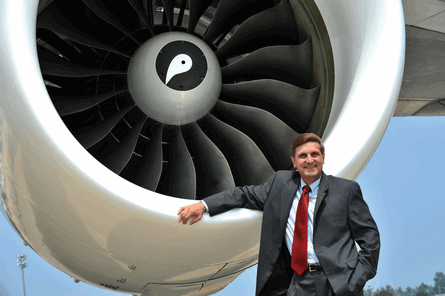Pratt & Whitney’s theme for Farnborough 2008 is ‘Redefining Flight’ – a reference to the US company’s geared turbo fan (GTF) engine, technology that it hopes will become the industry standard for powering the next generation of single-aisle airliners.
P&W president Steve Finger says the GTF engine has completed 250 hours of ground testing ahead of schedule, and a flight test engine was being mounted on to a Boeing 747 flying test bed aircraft for imminent trials. The GTF will also be mounted onto an Airbus A340 for further flight-testing later in the year.
Commenting on the so-called ‘architecture battle’ between the major engine builders, Finger says that he believes that it’s a no-contest and the GTF will prove to be the obvious choice. In terms of noise, fuel-burn and emissions, Finger believes GTF technology is superior to the open rotor concept preferred by GE and Rolls-Royce – at least at this stage in the research phase.
 |
|---|
“The airline market is in turmoil with oil at $140 a barrel and it could easily get far worse,” he says. “The industry needs solutions as quickly as possible. We’re already seeing a resurgence in popularity for the PW100 turboprop engine and I believe that powerplants of this type are the best thing for regional aircraft of between 70 and 100 seats flying over sectors of up to 500nm.
“GTF technology is preferable for single-aisle aircraft of more than 90/100 seats flying sectors of more than 500nm, primarily because turboprops are slower for passengers while from the airlines’ perspective, lower speeds mean fewer revenue-earning flights a day.”
Open-rotor engines will, he believes, be far too noisy and difficult to integrate with non-radical airframes. “The world is not ready to trade fuel burn for noise,” Finger says.
“People have criticised our GTF technology for being over-complicated but we have 40,000 very reliable turboprop engines out there and they have a 10:1 gearbox compared with the GTF’s 3:1 ratio. Our experience shows that the gearbox doesn’t even come in the top ten causes of unscheduled engine removals and the GTF gearbox is half as complex as the one on the PW100. Indeed, the GTF has half the number of low-pressure sections, compared with non-GTF engines and this too gives net reliability gains. Compared to today’s engines, the GTF would give fuel savings of $1.5m per aircraft per year.”
‘Re-defining Flight’ also applies to P&W’s patented EcoPower engine wash system. Using nothing but distilled water and some cleverly-designed nozzles, the system is a closed-loop, environmentally-friendly process that uses atomized water to wash aircraft engines. Not only does the system avoid potentially harmful run-off from the wash process (all water is collected, cleaned and re-used) it also is more effective and much faster than traditional methods.
The EcoPower system improves engine performance and extends time on-wing for operators of P&W, IAE, GE, Rolls-Royce and CFM engines. The EcoPower process can reduce fuel burn by as much as 1.2% and increase exhaust gas temperature margins by as much as 15°C.
By cleaning new customer Singapore Airlines’ engines, performance data shows that the airline can expect to save close to $15m in fuel costs and reduce CO2 emissions by 58,000 tonnes," says Finger. “EcoPower is an environmentally responsible way to help SIA keep their engines on-wing longer.”
Source: Flight International
















